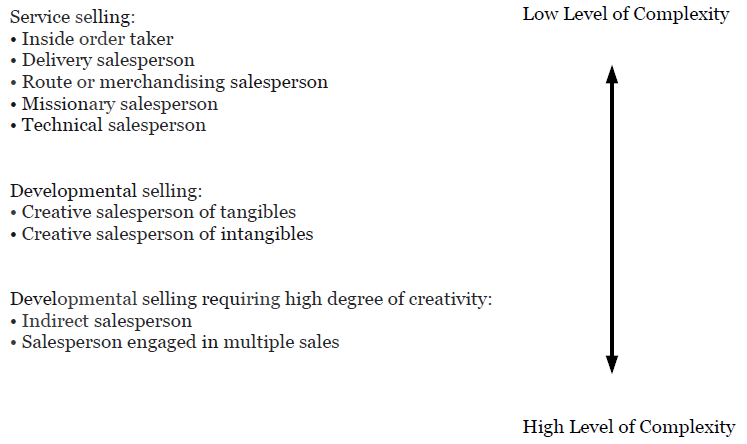Considerable differences exist in the various kinds of selling tasks. Early writers provided two-way classification of selling jobs, consisting of service selling, which focuses on obtaining sales from existing customers, and developmental selling, which is not as concerned with immediate sales as with converting prospects to customers.
|
Factor |
Personal selling |
Mass selling |
|---|---|---|
|
Speed in a large audience |
slow |
fast |
|
Cost per individual reached |
high |
low |
|
Ability to attract attention |
high |
low |
|
Clarity of communications |
high |
moderate |
|
Chance of selective screening |
moderate |
high |
|
Direction of message flow |
two way |
one way |
|
Speed of feedback |
high |
low |
|
Accuracy of feedback |
high |
low |
Most sales positions require some degree of both types of selling. Sales jobs can be classified on a continuum of service selling at one end to developmental selling at the other. Nine types of sales jobs are classified on this continuum (see Figure 8.11).
Service selling involves the following participants:
- Inside order taker: predominantly waits on customer; for example, the sales clerk behind the neckwear counter in a men's store.
- Delivery salesperson: predominately engaged in delivering the product; for example, persons delivering milk, bread, or fuel oil.
- Route or merchandising salesperson: predominantly an order taker, but works in the field; for example, the soap or spice salesperson calling on retailers.
- Missionary salesperson: position where the salesperson is not expected or permitted to take an order but to build goodwill or to educate the actual or potential user; for example, the distiller's missionary and the pharmaceutical company's detail person.
- Technical salesperson: major emphasis is placed upon technical knowledge; for example, the engineering salesperson who is primarily a consultant to client companies.
Developmental selling involves the following participants:
- Creative salesperson of tangibles: for example, salespersons selling vacuum cleaners, refrigerators, siding, and encyclopedias.
- Creative salesperson of intangibles: for example, salespersons selling insurance, advertising services, and educational programs.
Developmental selling, but requiring a high degree of creativity, involves the following participants:
- Indirect salesperson: involves sales of big ticket items, particularly of commodities or items that have no truly competitive features. Sales consummated primarily through rendering highly-personalized services to key decision-makers in customers' organizations.
- Salesperson engaged in multiple sales: involves sales of big-ticket items where the salesperson must make presentations to several individuals in the customer's organization, usually a committee, only one of whom can say yes, but all of whom can say no. For example, the account executive of an advertising agency who makes presentation to the agency selection committee. Even after the account is obtained, the salesperson generally has to work continually to retain it.

While the developmental-service and oriented classifications are helpful to better our understanding of the selling job, there are several other traditional classifications.
- 3845 reads






